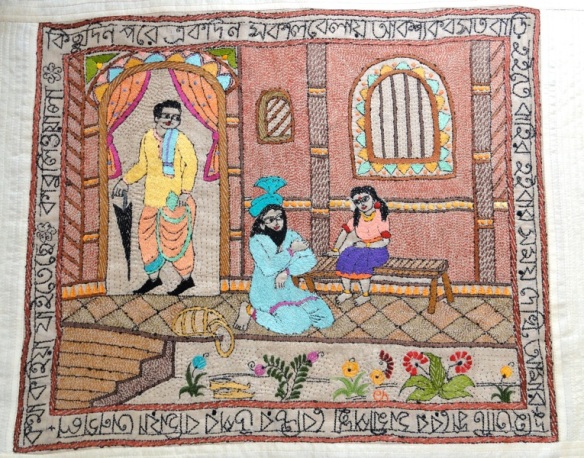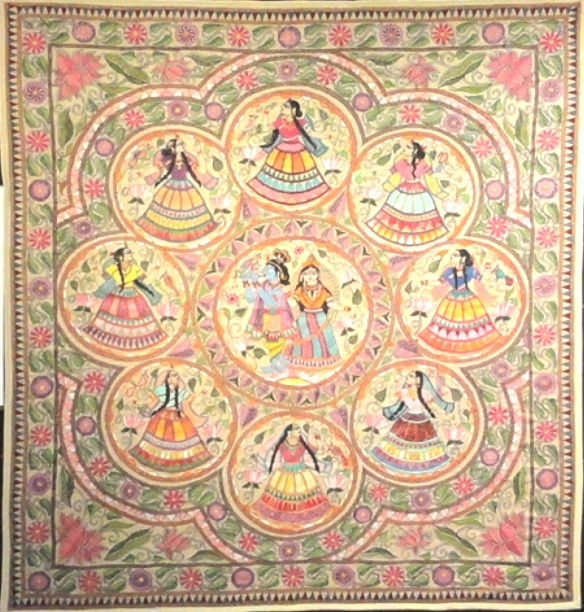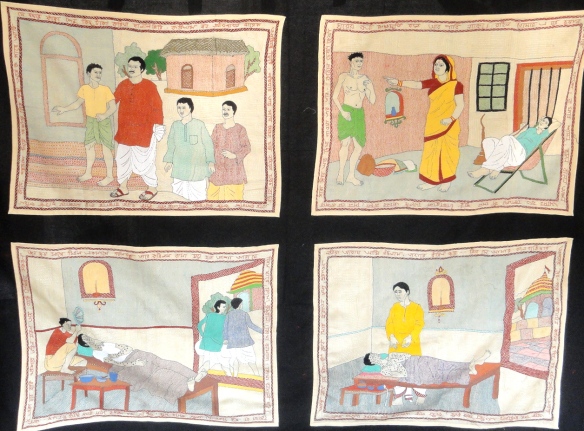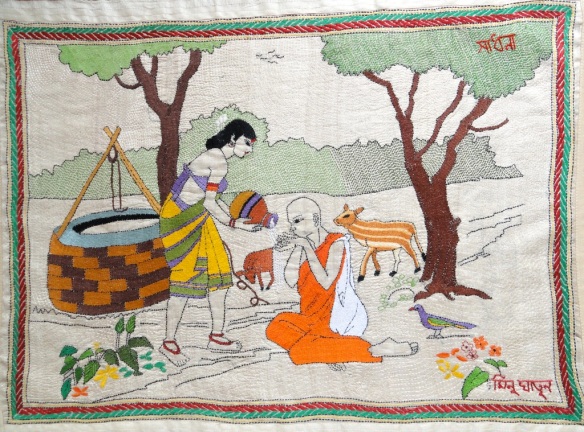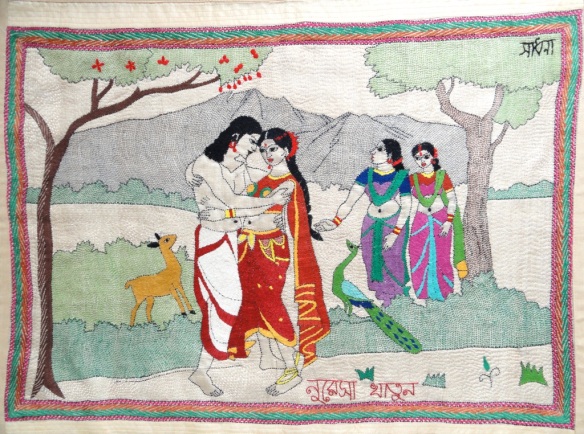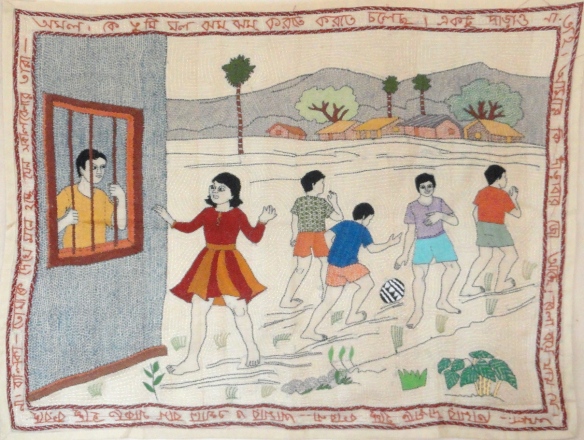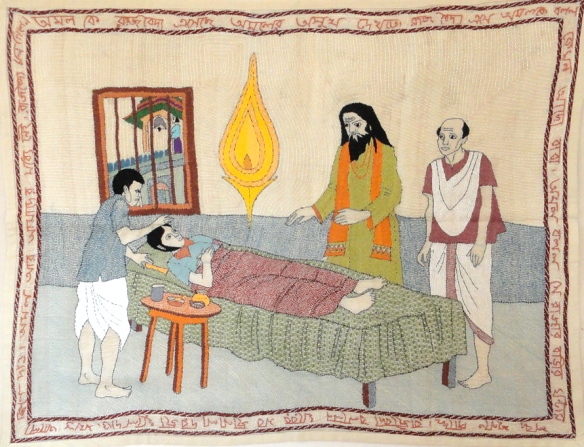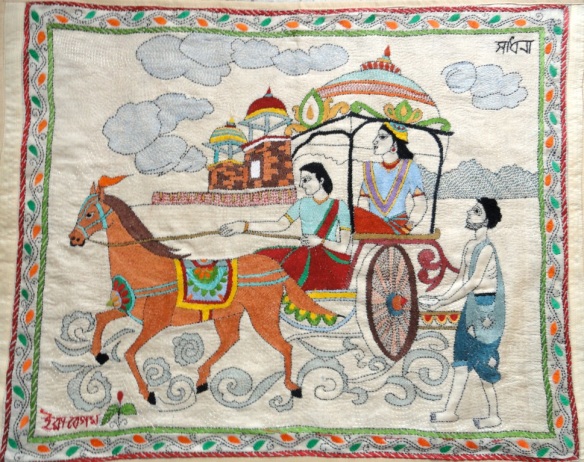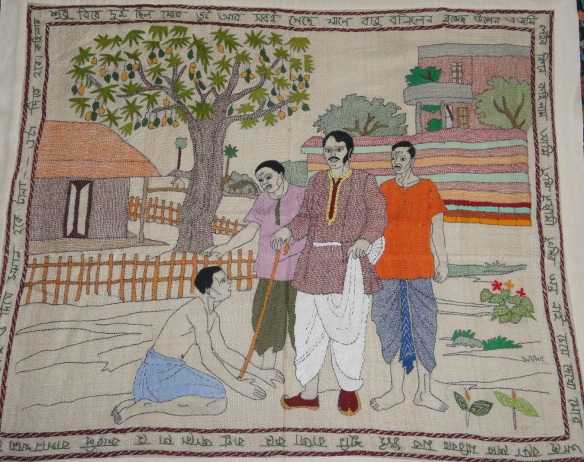The kantha is the story of the ingenuity and creativity of the women of rural Bengal. Centuries ago they began to transform tattered cloth into beautiful warm quilts by recycling and layering old saris and dhotis. The imagery included simple, traditional village vignettes, scenes from the Raj and pictures of deities. These were stitched onto layers with such precision that often the reverse was as neat as the obverse. And each kantha told a different story.
In the 1940s the kantha revival movement started in Kala Bhavan, Santiniketan, as a rural reconstruction program promoted by Protima Devi, the daughter-in-law of Rabindranath Tagore. Srilata Sarkar, a student of Kala Bhavan, was a great artist and a promoter of kantha and aided Protima in her efforts.
In 1985 Shamlu Dudeja revived these earlier initiatives and expanded the scope to reach outside of Bengal. She began work with a group of casual kantha artists from Shantiniketan who were inspired to stitch on one layer of silk rather than the multi-layered cottons previously used for quilts.
Under the brand name of Malika’s Kantha Collection, Shamlu picked up the threads, carried on with relentless effort and brought the kantha to the attention to people in India and Britain. Her daughter, Malika, helped her in the initial efforts of promoting kantha to the urban elite in Kolkata. With the help of a group of team leaders they started a non-government organization called Self Help Enterprise (SHE), which employed women in rural Bengal.
Shamlu Dudeja’s efforts transformed the kantha and she developed it from a poor man’s quilting stitch to an exquisite decorative stitch suitable for fashion and home furnishings. These kantha textiles now appeal to a large section of socially conscious citizens of the world and their worth is appreciated far beyond the borders of their native Bengal.
To honor the 150th year of Rabindranath Tagore’s birth Shamlu Dudeja conceived a magnificent project to honor the poet laureate – Tagore in Kantha. Rabindranath Tagore, the Bard from Birbhoom, echoed the spirit of Bengal in his songs and literary masterpieces. Although Bengal’s signature craft, kantha, does not find mention in Tagore’s writings his family probably used them.
Rabindranath Tagore, writer, philosopher and painter was the ambassador of Indian culture to the rest of the world. Although most famed for his poetry, Tagore was a creative genius who played a crucial role in the cultural renaissance of India and Bengal in the 19th and early 20th century. His multifaceted talent also found expression in reviving traditional and folk art forms while at the same time drawing on world cultural influences. At Sriniketan, adjacent to Tagore’s university town Santiniketan, there was a focused attention on imparting fresh life into traditional handicrafts and rural skilled work.
Tagore in Kantha is Shamlu’s latest contribution to the cultural heritage of rural Bengal and it is a masterwork of creativity and artistry. The concept was to illustrate the scenes from Tagore’s writings on tussar silk panels in fine kantha stitch. The creativity and talent of the rural women was at their best and resulted in 65 brilliant panels. The work they produced was comparable to fine art and worthy of any art gallery.
Under a full moon on 18 February 2011 His Excellency, Shri MK Narayanan, Governor of West Bengal launched the Tagore in Kantha exhibition on the lawns of the Raj Bhawan, Kolkata. That evening the kantha artisans sat on the floor of a replica mud hut and embroidered until they were invited to the well-lit stage where they received SHE Awards for Excellence in Kantha from Shri MK Narayan. Against the backdrop of the grand heritage building, the women shone with smiles on their faces and their heads held high. The effect was magical. The story of their lives, from a village hut to the stage of Raj Bhawan, was told amidst the thunderous applause of the eminent guests.
Kantha embroidery is treasured not only for its unmatched beauty but also for the role it plays in empowering the daughters of rural Bengal with confidence and a sense of self-worth. Creating these fine textiles enables women to lead a more dignified, independent existence as a result of their hard work and initiative. Their exhibit was so popular, that it was moved to Nandalal Bose Gallery at the Indian Council of Cultural Relations, Kolkata for a month. It has traveled to Cairo, Egypt, Dhaka, Bangladesh and Yemen.
For further information on scheduling an exhibition or purchasing kantha panels contact:
Shamlu Dudeja, Chairperson
Calcutta Foundation
Self Help Enterprise (SHE)
4/1 Alipore Park Road,
Kolkata 700027
dudeshamlu@gmail.com

